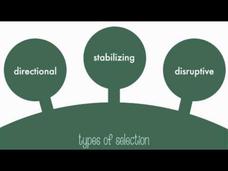Bozeman Science
LS2D - Social Interactions and Group Behavior
Humans aren't the only ones with social networking skills! Examine a fascinating video resource focused on standard LS2D of the Next Generation Science Standards. The narrator guides you through the organization within groups, the...
Bozeman Science
LS4B - Natural Selection
Would you survive natural selection? A video lesson prepares teachers across multiple grades to teach the concept of natural selection. The instructor explains the components of the concept and offers helpful examples.
Stated Clearly
Does the Theory of Evolution Really Matter?
Without the theory of evolution, we wouldn't understand the origins of HIV. The video explains three mysteries solved using the theory of evolution. It opens with shrinking fish, then the origins of HIV, and finally why grasslands turn...
Stated Clearly
What is Natural Selection?
If you carefully observe populations with short life cycles, you can observe natural selection happening. The video explains what natural selection is, how scientists theorized it, and how science proves the concept. It highlights the...
Stated Clearly
What is Evolution?
A short video offers a simple, yet engaging, explanation of the theory of evolution using amoebas as an example. The narrator uses the example of the evolution of dog breeds as an example of how humans can influence the course of change.
Teacher's Pet
History of Evolutionary Thought
Charles Darwin and Alfred Russel Wallace jointly created the theory of evolution by natural selection. The video explains the scientists that came before and after this pivotal moment. Many still debate why we often forget about Wallace...
Teacher's Pet
Types of Natural Selection
Natural selection—good things come to those who mate. The video introduces the idea of natural selection. Then it details three types: directional, stabilizing, and disruptive. It includes both graphs and examples for each type.
Bozeman Science
Evolution Continues
Peacocks, when fanning their feathers to attract females, shake the feathers, creating an inaudible sound for humans but one that female hens can hear, even from far away. In the video, scholars explore evolution by analyzing...
Bozeman Science
Ecological Selection
Humans, through artificial selection, created a dog that is hypoallergenic, loves water, is good with kids, very smart, and comes in a variety of colors — a labradoodle. Through the analysis of dog breeds, class members explore...
Bozeman Science
Microevolution
If some genes were exposed to microwaves, would that cause microevolution? In the video, scholars learn about microevolution or any change in the allele frequency of a population. The instructor explains the five ways microevolution...
Crash Course
Population Genetics: When Darwin Met Mendel
Learners explore population genetics, or how populations of species change over time, leading to evolution with a video that brings together the principles of Mendel and Darwin and explains and models the Hardy-Weinberg equation.
Amoeba Sisters
Natural Selection and the Bacterial Resistance
Biological fitness involves the number of offspring you produce and is not dependent on working out. The video explains natural selection using cartoon graphics of frogs on a log. Then it introduces evolution through antibiotic...
TED-Ed
The Past, Present and Future of the Bubonic Plague
It may be startling to know that the same bacteria responsible for the Bubonic Plague in the mid-fourteenth century still exists today. But don't worry, this video examines the causes and effects of the Black Death, and why the disease...
TED-Ed
What Causes Antibiotic Resistance?
There are ten times more bacteria cells than human cells in the average person, and while many of them are helpful, there are some that can be deadly. This video explores the on-going battle between people and these microscopic...
Stated Clearly
Can Science Explain the Origin of Life?
How did life on earth begin? Is there a scientific explanation that could show how life arose from chemical reactions? Discover the answers to these questions and more as you watch a basic explanation of the hypotheses currently being...
MinutePhysics
Evolution vs. Natural Selection
Clear up the confusion between natural selection and evolution with this cartoon. A hand draws diagrams and scenery as a voice narrates. This little feature is ideal for introducing these two concepts to beginning biologists.
Howard Hughes Medical Institute
The Making of the Fittest: Evolving Switches, Evolving Bodies
How did the stickleback fish, which was once ocean bound, evolve to be able to persist in freshwater lakes? Hear from the scientists who identified the genes and related switches that allowed these survivors to adapt. In addition to the...
Stated Clearly
What is Natural Selection?
Examine exactly what is meant by natural selection, as well as how it works in nature and through the assistance of humans. Presented with fun graphics and simple narration, the complex topic of natural selection is clearly explained in...
Stated Clearly
What is Evolution?
Learn about the basics of the mechanism of evolution and the importance of natural selection, and examine evidence showing that we are seeing evolution playing out in every organism we encounter. In an engaging and easy-to-follow video,...
Curated OER
Charles Darwin (Part 2)
Part two of this entertaining series looks at Darwin's visit to the Galapagos, his return home, and his determination to support his theories with evidence. What fun!
Curated OER
Natural Selection
It's Mr. Anderson, and he's ready to explain natural selection! Be excited, because he has the ability to make scientific biology and genetic functions in terms of natural selection make sense. With great examples and a clear and gentle...
Curated OER
Charles Darwin, Part 3/3
This delightfully informative series concludes with the publication of DarwinÕs The Origin of Species and subsequent books. This is the final part of a three-part series.
Curated OER
Competition, Predation, and Symbiosis
Each biome has self sustaining communities, but how did these unique and stable communities form? Investigate how these evolved with changing animal interactions.
Curated OER
The Origin of Life - Scientific Evidence
Ever wish there was a guest lecturer to help you explain the origins of life? Invite Mr. Anderson into your room with this 14-minute video lecture that describes the origins of life, age of the earth, and how scientists know what they do...























